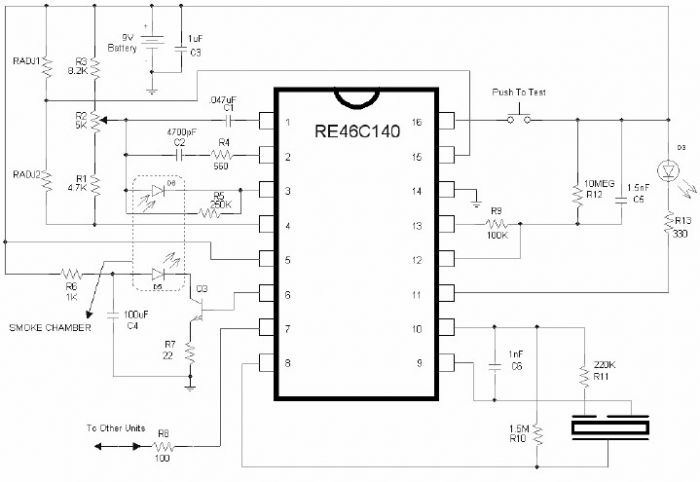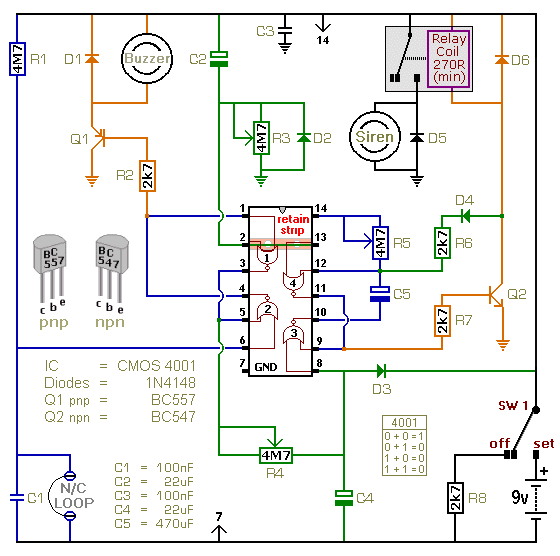
smoke detector alarm schematic re46c140

The RE46C140 circuit can be utilized to design a simple smoke detector alarm with minimal external electronic components. The RE46C140 integrated circuit (IC) is a low-power CMOS photoelectric smoke detector IC that encompasses all necessary features for a photoelectric smoke detector project. An internal oscillator provides power to the smoke detection circuitry for 100 microseconds every 10 seconds, ensuring that standby current remains low. When smoke is detected, the detection rate increases to confirm an alarm condition. During standby, the LED is pulsed on for 10 milliseconds every 43 seconds. In a local alarm condition or during a push-to-test event, the LED pulse frequency rises to once every 5 seconds. In the case of a remote alarm, the LED remains inactive. In timer mode, the LED is pulsed on for 10 milliseconds every 10 seconds. A comparator assesses the output of the photo amplifier against an internal reference voltage. If the specified number of consecutive smoke conditions is detected, the device activates a local alarm and the horn is triggered. The bidirectional I/O pin facilitates the interconnection of multiple detectors. During a local alarm condition, this pin is driven high immediately via a constant current source, and shorting this output to ground does not result in excessive current. The I/O pin is disregarded as an input during a local alarm.
The RE46C140 integrated circuit is specifically designed for smoke detection applications, leveraging its low power consumption to enable prolonged operational life in battery-powered devices. The internal oscillator and associated timing circuitry are critical for managing the device's power consumption while maintaining sensitivity to smoke particles. The photoelectric detection method employed allows for the identification of smoldering fires, which are often missed by ionization-type detectors.
The LED indicator serves multiple functions, providing visual feedback during normal operation, alarm conditions, and test modes. The pulsing behavior of the LED in standby mode helps to confirm the operational status of the device without drawing significant power. The increased pulse rate during alarm conditions ensures that the user is alerted promptly to the presence of smoke.
The comparator circuit is essential for the smoke detection process, as it continuously monitors the output from the photo amplifier. This feedback mechanism ensures that only genuine smoke conditions trigger an alarm, reducing the likelihood of false alarms caused by transient environmental factors. The ability to interconnect multiple detectors via the bidirectional I/O pin enhances the system's flexibility, allowing for networked smoke detection solutions in larger areas.
Overall, the RE46C140 IC provides a robust platform for developing reliable smoke detection systems, combining efficiency, sensitivity, and user-friendly features into a compact design.Using the RE46C140 circuit can be designed a very simple smoke detector alarm using few external electronic components. The RE46C140 IC is a low power CMOS photoelectric type smoke detector IC that will provide all the required features for a photoelectric type smoke detector project.
An internal oscillator strobes power to the smoke detection c ircuitry for 100us every 10 seconds to keep standby current to a minimum. If smoke is sensed the detection rate is increased to verify an alarm condition. In standby the LED is pulsed on for 10mS every 43 seconds. In a local alarm condition or the push to test alarm the LED pulse frequency is increased to once every 5 seconds. In the case of a remote alarm the LED not active. In the timer mode of operation the LED is pulsed on for 10mS every 10 seconds. A comparator compares the photo amp output to an internal reference voltage. If the required number of consecutive smoke conditions is met the device will go into local alarm and the horn will be active.
The bidirectional IO pin allows interconnection of multiple detectors. In a local alarm condition this pin is driven high immediately through a constant current source. Shorting this output to ground will not cause excessive current. The IO is ignored as an input during a local alarm. 🔗 External reference
The RE46C140 integrated circuit is specifically designed for smoke detection applications, leveraging its low power consumption to enable prolonged operational life in battery-powered devices. The internal oscillator and associated timing circuitry are critical for managing the device's power consumption while maintaining sensitivity to smoke particles. The photoelectric detection method employed allows for the identification of smoldering fires, which are often missed by ionization-type detectors.
The LED indicator serves multiple functions, providing visual feedback during normal operation, alarm conditions, and test modes. The pulsing behavior of the LED in standby mode helps to confirm the operational status of the device without drawing significant power. The increased pulse rate during alarm conditions ensures that the user is alerted promptly to the presence of smoke.
The comparator circuit is essential for the smoke detection process, as it continuously monitors the output from the photo amplifier. This feedback mechanism ensures that only genuine smoke conditions trigger an alarm, reducing the likelihood of false alarms caused by transient environmental factors. The ability to interconnect multiple detectors via the bidirectional I/O pin enhances the system's flexibility, allowing for networked smoke detection solutions in larger areas.
Overall, the RE46C140 IC provides a robust platform for developing reliable smoke detection systems, combining efficiency, sensitivity, and user-friendly features into a compact design.Using the RE46C140 circuit can be designed a very simple smoke detector alarm using few external electronic components. The RE46C140 IC is a low power CMOS photoelectric type smoke detector IC that will provide all the required features for a photoelectric type smoke detector project.
An internal oscillator strobes power to the smoke detection c ircuitry for 100us every 10 seconds to keep standby current to a minimum. If smoke is sensed the detection rate is increased to verify an alarm condition. In standby the LED is pulsed on for 10mS every 43 seconds. In a local alarm condition or the push to test alarm the LED pulse frequency is increased to once every 5 seconds. In the case of a remote alarm the LED not active. In the timer mode of operation the LED is pulsed on for 10mS every 10 seconds. A comparator compares the photo amp output to an internal reference voltage. If the required number of consecutive smoke conditions is met the device will go into local alarm and the horn will be active.
The bidirectional IO pin allows interconnection of multiple detectors. In a local alarm condition this pin is driven high immediately through a constant current source. Shorting this output to ground will not cause excessive current. The IO is ignored as an input during a local alarm. 🔗 External reference





